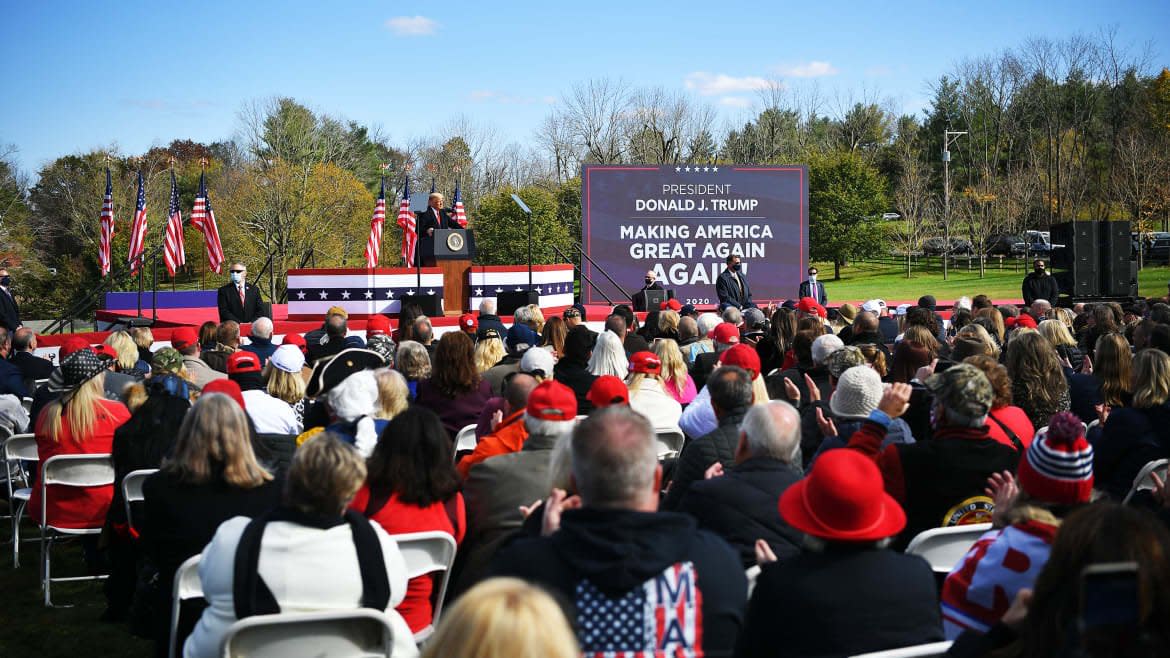Stanford Study Links Trump Rallies to 700 COVID-19 Deaths

Eighteen Trump rallies may have led to more than 700 COVID-19 deaths, including among people who did not attend the rallies, according to a new working paper from Stanford University researchers.
While Joe Biden has tailored his presidential campaign toward smaller, more socially distanced events during the pandemic, President Donald Trump has made a selling point of his packed rallies, where mask use is often scarce. The Stanford paper studied 18 Trump rallies this year, and linked them to a significant spike in COVID-19 cases—approximately 30,000—in surrounding counties.
The paper, from the school’s economics department, has not been peer reviewed, leading epidemiologists to raise some caveats about its findings. However, one such infectious disease expert told The Daily Beast that the study’s broader findings do suggest a post-Trump COVID bump, and further illustrate the effect of wearing a mask.
The study’s authors wrote that their findings affirmed previous warnings about large gatherings.
Biden Team Cancels Texas Event After Highway ‘Ambush’ by MAGA Cavalry
“Our analysis strongly supports the warnings and recommendations of public health officials concerning the risk of COVID-19 transmission at large group gatherings, particularly when the degree of compliance with guidelines concerning the use of masks and social distancing is low,” they wrote. “The communities in which Trump rallies took place paid a high price in terms of disease and death.”
Dr. Jeffrey Klausner, an infectious diseases expert at UCLA who was not involved with the study, said it “does indeed raise the possibility that these outdoor rallies increased the incidence of COVID in counties where they occurred.”
Klausner raised several caveats, noting that the study’s authors had not individually counted deaths, but looked at post-rally COVID surges, applied COVID death rates in the affected counties and predicted the number of deaths that had resulted from the rallies. The method meant researchers could not control for certain demographic factors, like the age of the affected people, he said. (Old age appears to be a significant factor in COVID death rates.)
Other epidemiologists, like Michael Mina of the Harvard T.H. Chan School of Public Health, also urged caution in extrapolating too much from the study.
“There are better ways to look at this data through actual infectious disease epidemic lenses,” Mina told Politico. “It offers a data point, but nothing I would want to draw any strong conclusions from. It is also so overtly political that it makes it hard to distinguish if there were decisions made out of perhaps unrecognized bias.”
Klausner and another epidemiologist who spoke to Politico said the study’s methods seemed generally sound, if a little speculative.
Fifteen of the 18 Trump rallies (held from June to September across multiple states) were held outside. COVID-19 research has suggested outdoor events with good ventilation are safer than indoor events with poor air circulation. Despite that, the researchers recorded a notable uptick in COVID-19 cases in surrounding areas after the rallies. Meanwhile, similar studies on outdoor Black Lives Matter rallies this summer did not find a notable outbreak among protest participants.
The difference might have been mask use, Klausner noted.
Although Black Lives Matter rallies “had crowding, a lot of people yelling, and other attributes we associate with COVID, you had a much higher percentage of mask-wearing,” compared to Trump rallies where fewer people were photographed in protective gear, he noted.
“Lack of masks may have been the key difference between Black Lives Matter rallies and Trump rallies,” Klausner said.
Get our top stories in your inbox every day. Sign up now!
Daily Beast Membership: Beast Inside goes deeper on the stories that matter to you. Learn more.

 Yahoo News
Yahoo News 
